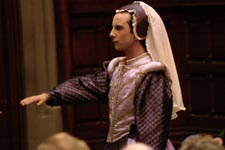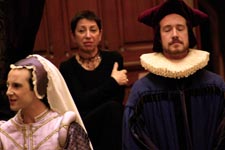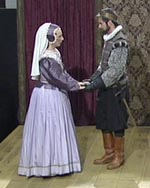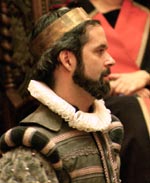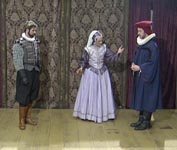- Edition: King Leir
King Leir
- Introduction
- Texts of this edition
- Contextual materials
- Facsimiles
146King Leir, Scene 22
Cast
Ragan: Derek Genova
Cambria: Scott Clarkson
Gallian Ambassador: Phil Borg
Performing Ragan (Sc. 22)
147Read about performing Ragan in Scene 17
Derek Genova, who played Ragan, took great relish in deceiving Cambria, making his character's manipulation of her husband blatant to the audience who knew she had arranged to have her father killed. He played the series of tactics apparent in the text with a verve comparable to Matthew Krist's manipulation of Cornwall in Scene 12. First she claims the prime right to mourn her father's absence (TLN 1891-1894), then she raises fears of some "charm" (TLN 1899) that may have conjured "infernal fiends" (TLN 1899) and her statement that she would "scratch out" Cordella's "hateful eyes" (TLN 1906) was a clear provocation to do the same in her cause. When her husband puts his faith in God's providence, she pushes him further by emphasizing the size of her grief and her resulting lack of patience (TLN 1913-4). Derek maintained a playfully arch awareness of his character's manipulative tactics rather than engaging with the ethics of her actions and their potentially dire consequences. In retrospect, I wonder if we might have given more weight to her character as the play progressed. She has already attempted the murder of her father and here she aggressively, although indirectly, pushes her husband into war with France.
148When the French Ambassador arrives she rudely challenges him and accuses him and his king and queen of treachery against her father, threatening him ultimately with torture (TLN 1836-49) (1936-1949). The Gallian Ambassador's consequent defense of his master and mistress and his implication that Ragan may be the guilty party results in her striking him (TLN 1966). The motivation of this moment in the SQM production was a little diluted by the playful quality of Ragan's initial manipulation of Cambria. More commitment to the viciousness of her attitude would have strengthened the scene.
149Following the Ambassador's exit she resumes her manipulation of her husband, challenging his manhood by complaining that she lives to "suffer this disgrace" (TLN 1971) of the Ambassador's impertinence while "no man" will take her "part" (TLN 1974). Genova's performance made it clear that Ragan was performing the role of the helpless woman in order to persuade Cambria to take up arms against the French and her sister. Her final provocation is to suggest that, should Cambria not respond with arms, Cordella will return to claim a "third part" of his land (TLN 1981). This final tactic appears to tip the balance as Cambria finally commits to defending his land and revenging himself on Cordella and the Gallian king (TLN 1983-1990).
150In the SQM production, Ragan's relentless pursuit of her objective was clear but the scene might have been stronger if we had concentrated on raising the stakes of the action rather than enjoying the playfulness of the dramatic ironies. Such an approach would also have made the task of Scott Clarkson, playing Cambria, a little easier.
Read more about performing Ragan.
Watch video of Scene 22 on the Performing the Queen's Men website. (The video footage is password protected. Click on "Cancel" in the pop-up window to obtain password.)
Performing Cambria (Sc. 22)
151Read about performing Cambria in Scene 5
This scene was a challenge for Scott as he thought it perfectly apparent that his character was being duped by his wife and therefore that his character would appear the fool. Within the conventions of 21st century psychological realism, the solution to such scenes is to have the deception be performed so convincingly that the duping appears fully justified. The playful SQM style that we developed for Ragan and Gonorill was dependent on the audience's awareness and enjoyment of the duping. Since the queen's manipulative tactics were made perfectly apparent to the audience, they were also perfectly apparent to the actors being duped. Jason Gray, playing Cornwall, faced similar problems in his scenes. The actors justified their characters' responses by introducing an element of naive insouciance to their characterizations as young wandering knights of romance, but in these climactic scenes the interpretations sat a little uncomfortably.
152The consequence of this choice was that Cambria became an object of comedy: the husband duped. The effect was consistent with the SQM approach to the play as a whole but the company style could have supported a more serious treatment of this scene and character. Added tensions might have have increased the sense of jeopardy during the long unraveling of the narrative that is to come.
Read more about performing Cambria
Performing the Gallian Ambassador (Sc. 22)
153Read about performing the Gallian ambassador in Scene 20
As with Cambria and Ragan, emphasizing the political weight and emotional import of this character's role would have increased the dramatic impact of this scene. In a production of Shakespeare with a regular rehearsal schedule, I likely would have done much more work with the actors to establish the social taboo of striking an ambassador in order to communicate to a contemporary audience some sense of its historical shock. Historicizing the action of the plays in such a way was one of my principle functions as facilitator of the SQM productions but while I provided the cast with the necessary background for this scene I don't think I emphasized its considerable gravity. The slap and the Ambassador's exit occurred at speed where a moment of pause might have marked this moment as a significant escalation of conflict in the play.
The Queen's Men Dramaturgy: Medley Style (Sc. 22)
154Read about the Queen's Men's medley style in Scene 19
Ragan's slap delivered to the French Ambassador has no direct consequence in the narrative. Cambria does not attack Gallia, nor is Gallia's arrival in England a result of the treatment of his diplomat. In terms of the causal pattern of action in the play, the moment is a dead end, although it does emotionally prepare the audience for what is to come. I suspect that it may have been the lack of connection to the subsequent action that led me to miss the dramatic potential in this scene, accustomed as I am, as a contemporary director, to tracking action from one scene to the next in causal chains. But the Queen's Men did not place great value on a unified, causal chain of action as we do today under the influence of neo-classicism and Stanislawski. Regardless of its impact on the rest of the play, the scene would have been more engaging in and of itself if we had increased its shock value and used it to indicate the depth of Ragan's depravity. I suspect such thematic and didactic function may well have been more central to the conception of the scene's original creators.
Read more about the Queen's Men's medley style.
Watch video of Scene 22 on the Performing the Queen's Men website. (The video footage is password protected. Click on "Cancel" in the pop-up window to obtain password.)

